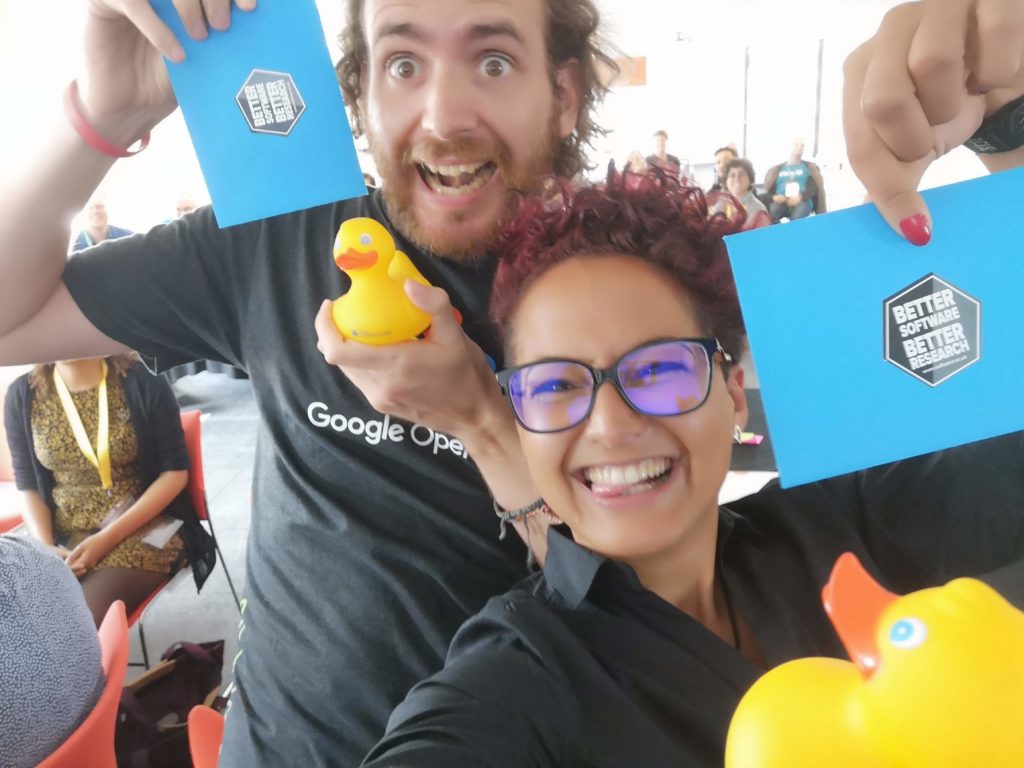Thanks to OBF support with a travel grant, I was able to attend the first European CarpentryConnect event in Manchester CCMcr19 organized by The Software Sustainability Institute.
 Colourful Manchester days post Pride weekend
Colourful Manchester days post Pride weekend
The Carpentries is a global community with a mission to teach essential data and foundational computational skills to researchers for conducting efficient, open, and reproducible research. The community includes instructors, trainers, maintainers and many more helpers and supporters on a global scale.
This was my first CCMcr19 and first Carpentry event. I was curious to know more about the community, their computational efforts and inclusive practices and CCMcr19 seemed like a good place to start.
I joined the computational world a few years ago, after moving from “wet” to “dry” lab. Shortly after the transition, I started delivering computational training and naturally, as a novice trainer, my main focus was on the material in terms of what to cover, how relevant it is, in what order do I present it and so on.
When I faced my first classroom, I quickly realized that prepping the material and doing my research was the easy part. Instead, I found myself thinking of the other factors that contribute to the participants’ learning experience such as; how do I address and interact with them, how do I account for their very diverse demographics such as gender, age and language.
 Diversity and Inclusion CCMcr19
Diversity and Inclusion CCMcr19
Ms. Brönte
Our classrooms today are not what they used to be 10 years ago. Participants come from all over the world and all walks of life, in other words, very diverse. This is especially true in computational training. For instance, bioinformatics training events in EMBL-EBI have two different types of attendees, one of which is made of plastic; robot avatars allowing students to participate virtually without having to be physically there.
Providing training and access to computational and cloud-based resources, enables researchers, especially those with limited resources, to work along with international partners, thereby contributing to open, reproducible research and helping improve research quality by bringing new perspectives.
Question is, how do we improve and adapt our training sessions to be more inclusive accounting for a diverse range of demographics?
I turned to the Carpentries community to learn from their collective experiences to help create a Dos and Don’ts checklist for computational teaching. The continuous contributions from trainers, as well as trainees, will help build a resource with advice on how to be mindful of diversity, equality and inclusion issues that play a role in training practices.
CCMcr19 was a three-day event with a very dynamic and interactive format with a twist.
Unlike many tech-oriented events, CCMcr19 covered a wide range of topics related to computational training, including advancing inclusive practices in the community and environmental initiatives.
My first day & first #CCMcr19, I’m impressed!! Lovely people, great food, environmental awareness, dog, magician, doodler and above all interesting discussions and tons of things to learn! Defo a conference with a twist 😉! Thanks to the organisers! #Day2 #BringItOn https://t.co/Dslqiz1HOe
— Dr. Sara El-Gebali (@yalahowy) June 26, 2019
To encourage attendees to contribute to reducing impact on the environment at the conference, the Reusable Cup Raffle was introduced. We took a photo of our reusable cup/other reusable items such as reusable lanyards and badges, then tweeted about it using the hashtag # CCMcr19ReusableLanyards & # CCMcr19ReduceCO2 and the raffle was drawn.
Guess who won?
 We won!
We won!
After learning about the Carpentries and their inspiring work on day 1. I carried out my workshop titled Dos and Don’ts for computational training on day 2. I was joined by 10 participants, all of whom have experience in delivering training.
 Group discussions
Group discussions
The first exercise we did was getting to know each other; background, expectations and anticipated outcomes.
“Know your audience”
After the groups formed organically, people started sharing their experiences and each group started noting down their observations, contributing to the list of advice.
“ Do’s and Don’ts in computational training”
As the discussion became more lively and engaging, it was evident that we needed a gatekeeper;
a person who can make sure that everyone is participating and getting along in an orderly fashion.
There were some interesting examples from the trainers which led to some thought-provoking advice, for example;
“Hands off my keyboard”
As a trainer, when asked for help, there is a tendency to grab the keyboard to “show” the students how to work out the task at hand. In doing so, we inadvertently diminish their autonomy, reduce their confidence and invade their personal space.
Other practical advice to display an open and inclusive space include introducing our pronouns at the start of the session. In doing so, the participants become aware that this is an inclusive environment where they are encouraged to express themselves.
We also discussed breaks during sessions, such as;
“Bio breaks”, short breaks of 5-10 minutes to allow participants time to go to the bathroom, drink water, and stretch to prevent people from taking breaks at different times and miss out on something.
“Brain Breaks”, a mental break of 1-3 minutes each hour of the session, to help participants to re-energize, re-focus and relax, allowing people to reflect or clear their minds.
Since we are focused on computational teaching, it didn’t go amiss to include advice on technological solutions to facilitate training sessions while catering for different abilities and needs.
Check out the list of Do’s and Don’ts in computational training and please feel free to share your tips and advice on GitHub.
Sara El-Gebali
Email: selgebali@gmail.com
Twitter: @yalahowy
GitHub: @selgebali